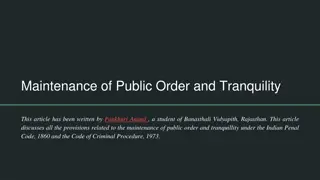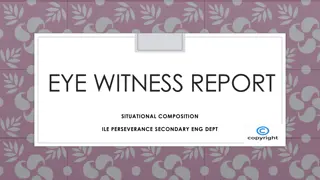Understanding Section 390 of the Indian Penal Code on Robbery
Section 390 of the Indian Penal Code discusses the concept of robbery and its elements of theft and extortion. It outlines that robbery involves imminent danger or the use of violence, and the offender voluntarily causes harm or induces fear to commit the crime. The section also provides explanations and illustrations regarding robbery from theft and extortion.
Download Presentation

Please find below an Image/Link to download the presentation.
The content on the website is provided AS IS for your information and personal use only. It may not be sold, licensed, or shared on other websites without obtaining consent from the author. Download presentation by click this link. If you encounter any issues during the download, it is possible that the publisher has removed the file from their server.
E N D
Presentation Transcript
INDIAN PENAL CODE 1860 SECTION-390(ROBBERY) LL.B I Year(Semester-II) (Subject-Law of Crime-I) (Paper IV, Unit-III) Dr. Vijay Kumar Rai Associate Professor, Deptt. Of Law Harishchandra P.G. College Varanasi
Sec.390 Robbery.In all robbery there is either theft or extortion. When theft is robbery. Theft is robbery if, in order to the committing of the theft, or in committing the theft, or in carrying away or attempting to carry away property obtained by the theft, the offender, for that end, voluntarily causes or attempts to cause to any person death or hurt or wrongful restraint, or fear of instant death or of instant hurt, or of instant wrongful restraint. When extortion is robbery. Extortion is robbery if the offender, at the time of committing the extortion, is in the presence of the person put in fear, and commits the extortion by putting that person in fear of instant death, of instant hurt, or of instant wrongful restraint to that person or to some other person, and, by so putting in fear, induces the person so put in fear then and there to deliver up the thing extorted.
Ingredients of Robbery:- (1) In all robberies there is either theft or extortion. ->Imminent danger or use of violence, and voluntarily are two important ingredients of robbery. (2) Theft is robbery if- -> In order to the commiting of the theft, or -> In commiting the theft, or -> In carrying away, or in attempting to carry away property obtained by theft,
(3) The offender for that end voluntarily causes or attempts to cause to any person- -> death, or -> hurt, or -> wrongful restraint, or -> fear of instant death, or hurt or wrongful restraint. (4) Extortion is robbery if the offender- -> is in the presence of the person put in fear. -> commits the extortion by putting that person in fear of instant death, instant hurt, or instant wrongful restraint to that person, or to some other person. -> by so putting in fear, induces the person so put in fear then and there to deliver up the thing extorted.
An Explanation attached to the Section:- The offender is said to be present if he is sufficiently near to put the other person in fear of instant death, of instant hurt, or of instant wrongful restraint. (1) In all robberies there is either theft or extortion- ->Robbery from theft [illustration (a)] ->Robbery from extortion [illustration (b) and (c)]
(2) In carrying away, or in attempting to carry away property obtained by theft- After commiting theft, death, hurt or wrongful restraint or fear of any of these is caused in order to carry away or attempting to carry away property obtained by theft, robbery is commited. Important Cases- Harish Chandra v. State of U.P., (1976) 2 SCC 795 Khusho Mahaton v. State of Bihar, 1980 Supp SCC 344 (3) For that end voluntarily causes or attempts to cause- Voluntarily has been given under Sec. 39. The use of violence will not convert theft into robbery unless the violence be commited for achieving one of the ends mentioned in Sec. 390. Important Cases- Padmanava Mahopatra 1983 Cri LJ NOC 238 (Orissa) State of Kerala v. Naduvectil Vishwanatham, 1991 Cri LJ 1501
(4) The word restraint implies abridgement of the liberty of a person against his will. Important Points:- Seizure of property in exercise of a bona fide right over it is not covered in the Sec. 390. Cases- Sardar Trilok Singh v. Satya Deo Tripathi, (1979) 4 SCC 396 Din Dayal v. Delhi Administration, 1991 Supp (2) SCC 220 The offence under Sec. 390 are cognizable, non-bailable and non- compoundable.























